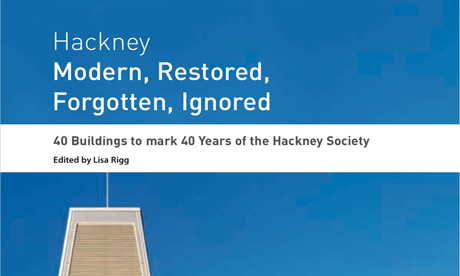Hackney: Modern, Restored, Forgotten, Ignored

The Hackney Society's new book
Hackney’s heritage organisation, the Hackney Society, marks 40 years with ‘Modern, Restored, Forgotten, Ignored’ – a book celebrating 40 of Hackney’s loved, lost, and saved buildings.
Founded in 1967, the Society was set up by a group of residents concerned about the Borough’s tower block culture, which became a quick solution to the post-war housing crisis.
As East London fell under the grip of industrial decline, many of the Hackney’s Victorian two up two down houses, warehouses and factories were left derelict, or demolished to make way for the great concrete tower blocks, which are still a key feature of the local skyline.
The remaining warehouses and depots quickly became spaces for musicians, artists and filmmakers during the 70s and 80s, adding to Hackney’s already established textile industry. The creative legacy lives on today, but as areas like Shoreditch become more desirable places to live –local creative industries are being priced out of the market.
From modern design to Hackney’s most loved, ‘Modern, Restored, Forgotten, Ignored’ is told through the eyes of local people as a collection of voluntary written contributions and photographs.
Each chapter profiles ten buildings working around four themes – ‘modern’ being the best of modern design; ‘restored’ – buildings that have been saved; ‘forgotten’ – buildings that have been lost; and ‘ignored’ – buildings in need of attention.
The New Lansdowne Club on Mare Street is probably the most desperately in need of attention. Donated to a charity commemorating the work of prison reformer Elizabeth Fry in 1845, the house was used as a refuge for women who had completed prison sentences.
At the time, many women and children were sent to prison without trial, living in appalling conditions. Fry was active in improving prison conditions and abolishing capital punishment. Since 2002, she has been depicted on Bank of England £5 notes. The Club is now stands derelict, and the Hackney Society are campaigning for it to be restored to its former glory.
Matt Payne’s chapter on Hackney Stadium is a welcome break from the otherwise quite dense history, showing off Hackney’s fun side. A night out at the dogs was a break from daily grind of the factories and warehouses in the 1930’s – even though the stadium was nothing more than a grass track and two stands.
The land was bought by the London Development Agency to make way for the Olympics and Hackney Stadium was eventually demolished in 2003 to be replaced by offices as part of the legacy proposals.
The photographs from the Hackney Archives bring home how much Hackney has changed over the years – from images of wartime evacuees to demolition shots of the tower blocks on the Trowbridge estate in 1985.
Placed against the colourful shots of Mossbourne Community Academy and Adelaide Wharf, it is clear how dramatically social and industrial life has changed in the last two decades, and the rich layers of social history that can be seen through local architecture.
The book is available to buy at Broadway Bookshop, Pages of Hackney and Stoke Newington Bookshop.
To order directly from the Hackney Society email: booksorders@hackneysociety.org
Cheques made payable to the Hackney Society for £14.95 plus £4 p&p (add £1.60 for each additional book).
We have ten books to give away in answer to the following question:What year was the Hackney Society founded?
Please send your answer to editor@hackneycitizen.co.uk
or
The Editor
(Hackney Society Competition)
The Hackney Citizen Ltd
9 Perseverance Works
38 Kingsland Road
London E2 8DD
